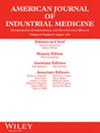Characterizing applications, exposure risks, and hazard communication for engineered nanomaterials in construction
Abstract
Background
Engineered nanomaterials (ENMs) may pose health risks to workers. Objectives were to characterize ENM applications in construction, identify exposure scenarios, and evaluate the quality of safety data sheets (SDSs) for nano-enabled construction products.
Methods
SDSs and product data were obtained from a public database of nano-enabled construction products. Descriptive statistics were calculated for affected trades, product categories, and types of ENMs. A sample of SDSs (n = 33) was evaluated using modified criteria developed by NIOSH researchers. Bulk analysis via transmission electron microscopy characterized nanoparticles in a subset of products.
Results
Companies report using >50 ENMs in construction products. ENM composition could not be determined via SDSs for 38.1% of the 907 products examined. Polymers and metal oxides tied for most frequently reported ENMs (n = 87, 9.6%). Nano silica, graphene, carbon nanotubes, and silver nanoparticles were also frequently reported. Most of the products were paints and coatings (n = 483, 53.3%), followed by pre-market additives, cementitious materials, insulation, and lubricants. Workers in twenty construction trades are likely to handle nano-enabled products, these particularly encompass cement and brick masons, painters, laborers, carpenters, glaziers, and insulators. A wide range of exposure scenarios were identified. SDSs were classified as satisfactory (18%), in need of improvement (12%), or in need of significant improvement (70%). Bulk analyses revealed discrepancies between actual ENM composition and those in SDSs.
Discussion and Conclusion
There has been significant progress investigating risks to construction workers posed by ENMs, but SDSs need major improvements. This study provides new insights on the use of ENMs in construction, exposure risks, and hazard communication.

 求助内容:
求助内容: 应助结果提醒方式:
应助结果提醒方式:


